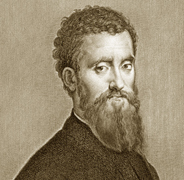GIULIO ROMANO
 |
| Giulio Romano - self portrait |
Giulio Pippi (Rome 1499 - Mantua 1546), better known as Giulio Romano, painter and architect, was the closest collaborator of Raphael, at his untimely death (1520), inherited the shop, spent the years immediately after to complete the “Stanze Vaticane” that Raphael had left unfinished, which as well as the Vatican Loggia, live Raphael, he had worked.
As architect he designed the Villa Lante in Rome and the Palazzo Maccarani Stati, but his most famous work of architecture is the Palazzo Te, which was built for Federico II Gonzaga in Mantua.
He became rich and powerful and built for himself a palace in the center of Mantua.
He would have to return to Rome to become the first architect of the building of St Peter, but in 1546 the death surprised him.
We talked about his career as an architect to point out the individuality and autonomy with respect to the great master. His experience as a painter can be divided between the time during which he collaborated with Raphael and the time following the death of his master.
The analysis of the first period is difficult because the work in the studio of Raphael followed a system that doesn’t allow you to go back to single individuals, so it’s hard to recognize the hand of Giulio. In the next period Giulio follows its own independent path, which is characterized by a marked design, which does not permit large prominence to colors.
He composed great frescoes in Rome at Villa Giulia and Villa Madama, in Mantua at Palazzo Te and Palazzo Ducale.
His paintings are exhibited in many museums: the Borghese Gallery, the National Galleries of Capodimonte in Naples, the Uffizi, the Galleria Nazionale in Parma, the Louvre, the Hermitage in St. Petersburg, the Pushkin in Moscow, the Kunsthistorisches Museum in Vienna, the National Gallery in London, the National Gallery of Scotland in Edinburgh, the Prado in Madrid, the Paul Getty Museum in Los Angeles and still in Rome, not in a museum, but in the church of Santa Maria dell’Anima we can see the Holy Family.
In the Galleria Nazionale d’Arte Antica shines the Madonna and Child, one of his best works painted around 1523 shortly after Raphael's death, yet already an expression of self-style of Giulio.
back |

